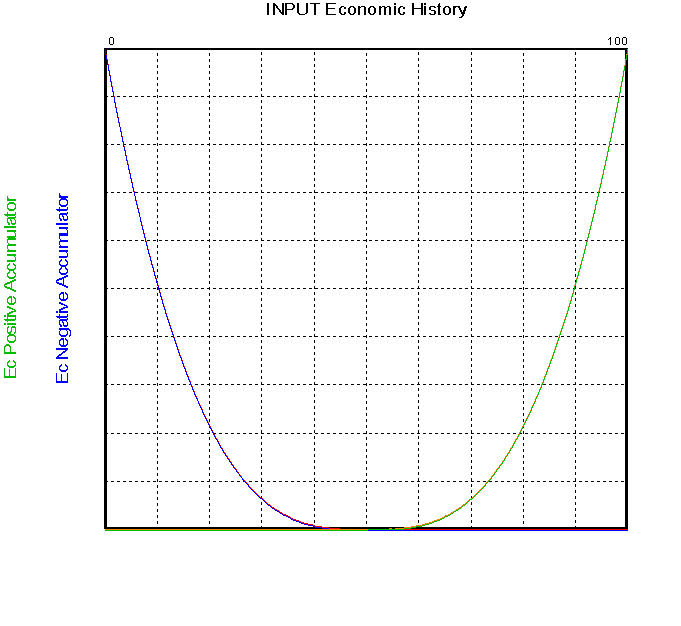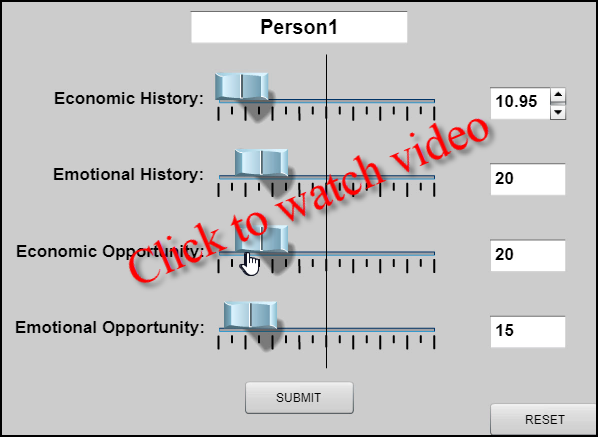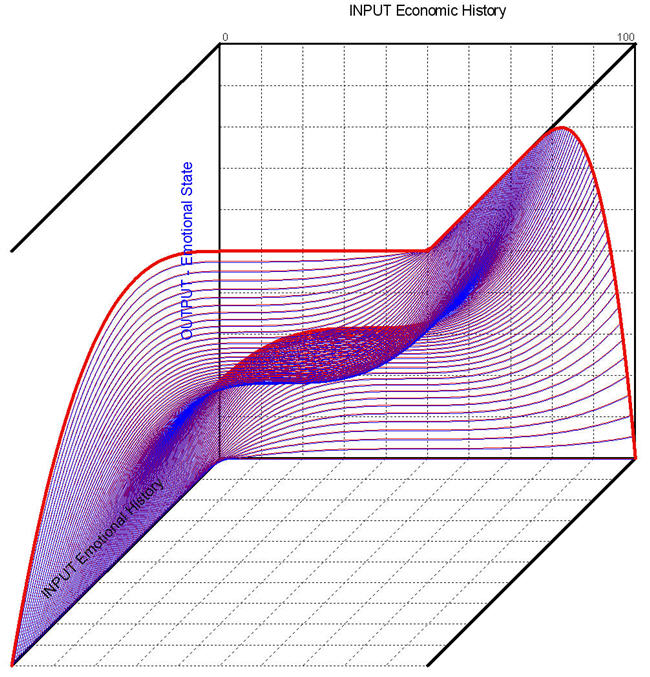
"Expectancy Violation Theory" as a model for how humans will respond to events (positive or negative)
Disclaimer: The emotional arousal model depicted here is only for demonstration purposes. Individuals have been abstracted so as not to highlight any individuals.
The user is asked to select the person to profile from the list. (Abstract names are used in the demonstration.) Once the target person is selected, a scroll bar is displayed where the user can suggest the intensity of an event (from extremely negative to extremely positive). When the user depresses the SUBMIT button, the event information is sent to the server, where it is combined with economic history, emotional history, economic opportunity, and emotional opportunity information from the database.
The KEEL Engine on the server calculates how the person will respond by fusing the event characteristic with the arousal state of the person.
The ability to model complex behavioral models is a strength of KEEL Technology and the KEEL "dynamic graphical language" which enables complex models to be visually decomposed so the user can see (in explicit detail) how variables interact. The models can be used in Modeling and Simulation of human-like behaviors. These models can also be embedded into software applications and devices where human-like behavior can be emulated with real-world devices that may need to interact with humans.
The general concept being demonstrated is that if the person's emotional arousal state is very negative (depressed) and that person is given a negative (threatening) event, then it will have little impact. On the other hand, the person with the negative emotional arousal state is given a positive event, it will have a more significant impact. The inverse is also true: If the person's emotional arousal state is very high and that person is given a very threatening event, then that person will have a large reaction, while a positive event will have a less significant impact.
Detailed Instructions are provided below.

This demonstration shows the deployment of a KEEL Engine in an Active Server Page (ASP) where the KEEL Engine was created in VBScript from the KEEL Toolkit. The KEEL Engine could also have been created in C++ .NET for web services hosting.
NOTE: The "Profiling" time lag is due to the communication time sending data to and from the server and due to the fact that the VBScript operating on the server is "interpreted". If the KEEL Engine was operating on the client machine without any need to access the server, the response would be immediate.
This demonstration also shows how KEEL can interpret emotional characteristics and model how profiling might be used to determine how that person might respond to an event or action taken toward him/her.
This demonstration system, unlike most of the other demonstrations, has the KEEL processing accomplished on the server. When this web page loads, a query is initialized to the server for a list of all the "persons" whose emotional profiles are stored on the server. A list box is populated with their names.

This chart shows that the impact of Economic History carries more weight at the boundary conditions (extremely negative or extremely positive), while it carries no impact in the middle. (This same relationship is characterized by Emotional History, Economic Opportunity, and Emotional Opportunity.)

The chart above shows the integration of Economic History and Emotional History in the KEEL Engine. When looking at the chart, the 50% point for "Economic History" and for "Emotional History" are the neutral points. A 0% value for each would be the most negative, while a 100% value would be the most positive. The system is actually integrating all four characteristics (Economic History, Emotional History, Economic Opportunity, and Emotional Opportunity). The Emotional State is then combined with the event characteristics to determine the impact.
 |
The first screen allows
the user to select the person to profile. The names come from the server. Note: In the samples provided, Person1 and Person2 have relatively negative emotional states, while Person3 has a very positive emotional state. |
 |
The second screen
appears after the user selects the person. This screen allows the user to
simulate an event. Adjust the scroll bar to identify the characteristics of the event. Then click on the SUBMIT button. |
 |
After the KEEL Engine
on the server integrates the information from the database with the event, this
screen is displayed with the results. The top bar (Emotional State) is the accumulation of the information from the 4 bars at the bottom that came from the database. The 2nd bar (New Event) came from the user in the previous screen. The 3rd bar (Impact of Event) is the integration of the New Event with the Emotional State. If this value is very large (positive or negative), then this indicates the potential for an irrational response. |
NOTE: A Configuration Tool is provided to add / edit "Person Characteristics".
The following diagram shows the data flow embedded in this demonstration. It operates as follows:

|
Copyright , Compsim LLC, All rights reserved |